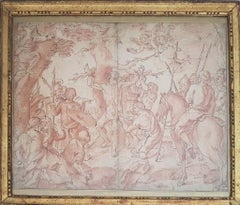Joachim von Sandrart Art
Joachim von Sandrart was born in Frankfurt, Germany, in 1606, but his family originated from Mons/Bergen. According to his dictionary of art called the Teutsche Academie, he learned to read and write from the son of Theodor de Bry, Johann Theodor de Bry and his associate Matthäus Merian, but at age 15, he was so eager to learn more of the art of engraving, that he walked from Frankfurt to Prague to become a pupil of Aegidius Sadeler of the Sadeler family. Sadeler, in turn, urged him to paint, whereupon, he traveled to Utrecht in 1625 to become a pupil of Gerard van Honthorst, and through him he met Sir Peter Paul Rubens when he brought a visit to Honthorst in 1627, to recruit him for collaboration on part of his Marie de' Medici Cycle. Honthorst took Sandrart along with him when he traveled to London. In 1627, Sandrart booked a passage on a ship from London to Venice, where he was welcomed by Johann Lis and Nicolas Régnier.
Sandrart then set out for Bologna, where he was met by his cousin on his father's side Michael le Blond, a celebrated engraver. With him, he crossed the mountains to Florence, and from there on to Rome, where they met Pieter van Laer. Sandrart became famous as a portrait-painter. After a few years, he undertook a tour of Italy, traveling to Naples, where he drew studies of Mount Vesuvius, believed to be the entrance to the Elysian fields described by Virgil. From there, he traveled to Malta and beyond, searching for literary sights to see and paint, and wherever he went, he paid his way by selling portraits. Only when he was done traveling did he finally return to Frankfurt, where he married Johanna de Milkau. Afraid of political unrest and plague, Sandrart moved to Amsterdam with his wife in 1637. In Amsterdam, he worked as a painter of genre works and portraits. He won a very good following as a painter, winning a lucrative commission for a large commemorative piece for the state visit by Maria de' Medici in 1638, which hangs in the Rijksmuseum. This piece cemented his reputation as a leading painter, and in 1645, Sandrart decided to cash in and go home when he received an inheritance in Stockau, outside Ingolstadt, Germany. Though he rebuilt the old homestead, it was burned by the French. He sold it and moved to Augsburg, where he painted for the family of Maximilian I, the Elector of Bavaria. When his wife died in 1672, Sandrart moved to Nuremberg, where he married Hester Barbara Bloemaart, the daughter of a magistrate there. This is where he started writing. Sandrart is well known as an author of books on art, some of them in Latin, and especially for his historical work, the Teutsche Academie, published between 1675–80.
1640s Old Masters Joachim von Sandrart Art
Ink
18th Century Old Masters Joachim von Sandrart Art
Ink, Archival Paper, Watercolor
17th Century Old Masters Joachim von Sandrart Art
Charcoal, Ink, Watercolor
19th Century Old Masters Joachim von Sandrart Art
Ink, Charcoal
19th Century Old Masters Joachim von Sandrart Art
Paper, Ink, Watercolor
16th Century Old Masters Joachim von Sandrart Art
Pen, Laid Paper, Ink
Mid-20th Century Old Masters Joachim von Sandrart Art
Ink, Laid Paper
19th Century Old Masters Joachim von Sandrart Art
Ink
2010s Old Masters Joachim von Sandrart Art
Paper, Ink
1750s Old Masters Joachim von Sandrart Art
Paper, Ink, Watercolor
1740s Old Masters Joachim von Sandrart Art
Ink, Watercolor
16th Century Old Masters Joachim von Sandrart Art
Pen, Ink
Mid-17th Century Old Masters Joachim von Sandrart Art
Ink, Watercolor, Vellum, Pencil

